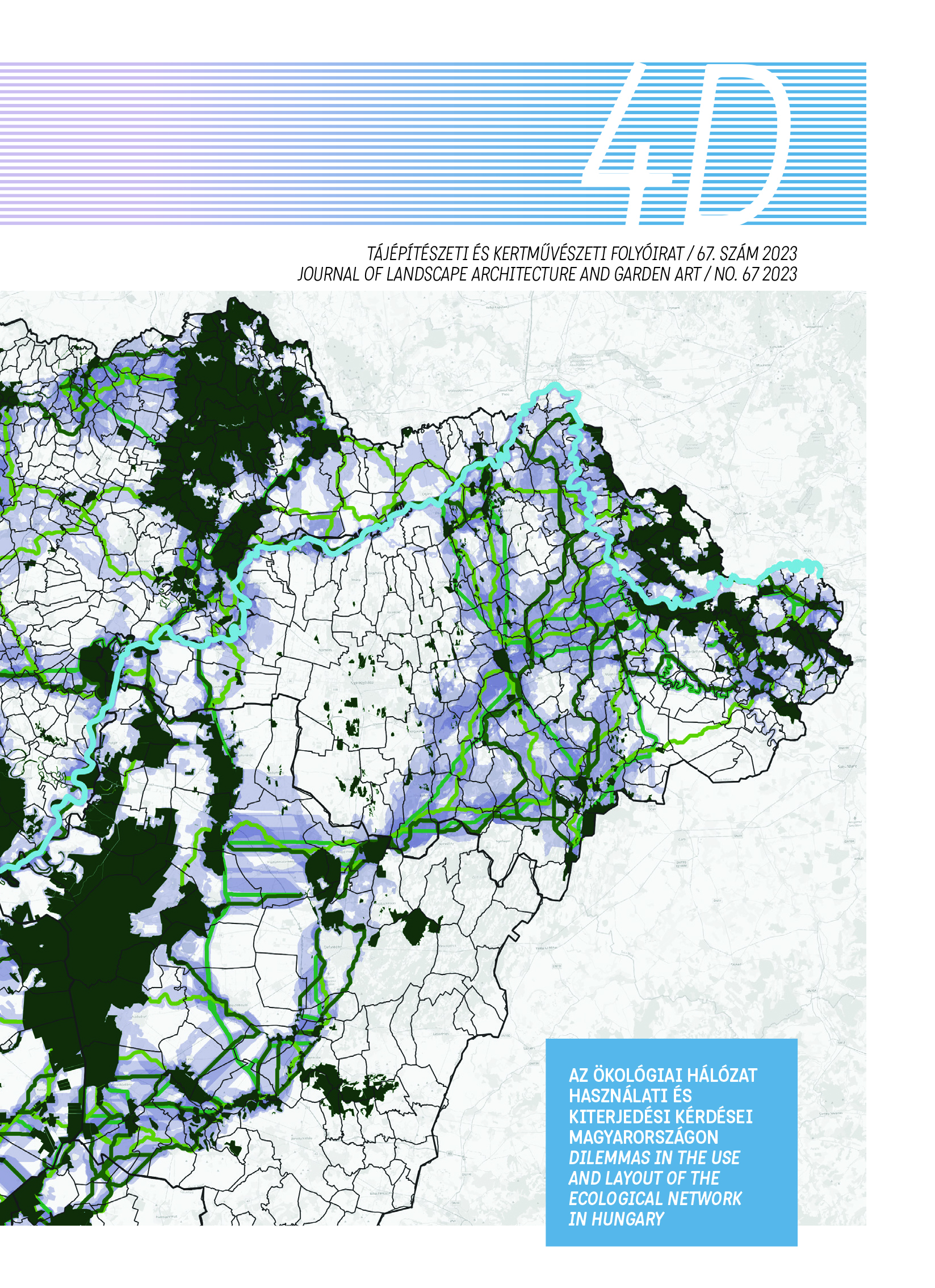Habitat quality assessment based on InVEST model - Zhengzhou, China
DOI:
https://doi.org/10.36249/4d.67.3699Keywords:
land use, habitat quality, urbanisation, Zhengzhou, ChinaAbstract
Human activities and global urbanisation have affected the integrity and continuity of ecological land, and resulted in the fragmentation of natural habitats and worldwide ecological security issues. Some ecological functions of landscape patches have been degraded or even lost. We need to study the impact of land use changes on natural habitats that are caused by urbanisation. As the research area, we selected Zhengzhou, a city in central China that has undergone rapid urbanisation in the early 21st century. By using the InVEST-habitat quality model and ArcGIS geographical analysis, we evaluated changes in land use and habitat quality in Zhengzhou from 2000 to 2020. The results show that: The area of construction land increased sharply by 806.76km2 from 2000 to 2010, while during 2010-2020 the growth rate slowed to 33km2 per year, and most of it was converted from arable land. The area of forest and grassland was also greatly reduced in 2000-2010, but did not change significantly in 2010-2020. This indicates that urban expansion gradually shifted from the acceleration of 2000-2010 to a period of stability in 2010-2020, and construction land has taken over a large amount of arable land. Habitat quality was higher in the mountain forests to the west and the south, while the low habitat quality areas in the eastern plain gradually expanded with the development of urban construction. The Yellow River, the most important river in China, was also negatively affected by urbanisation in the north of Zhengzhou, but its habitat quality gradually improved during 2010-2020. In the central urban area, habitat quality was improved in some places due to the creation of green spaces and artificial lakes in recent years, and also through with the improved maintenance of green spaces. However, it is worth continuing to explore whether artificial lakes and large-scale green spaces are the optimal solutions to improve habitat quality. In the future, we will be able to seek the best cost-effective ecological protection methods in terms of economic investment and ecological benefits.
References
Alcamo Joseph – Bennett Elena M. – Millennium Ecosystem Assessment (Program) (2003): Ecosystems and human well-being: a framework for assessment. Island Press: Washington, DC.
Tscharntke Teja – Tylianakis Jason M. – Rand Tatyana A. – Didham Raphael K. – Fahrig Lenore – Batáry Péter – Bengtsson Janne – Clough Yann – Crist Thomas O. – Dormann Carsten F. – Ewers Robert M. – Fründ Jochen – Holt Robert D. – Holzschuh Andrea – Klein Alexandra M. – Kleijn David – Kremen Claire – Landis Doug A. – Laurance William – Lindenmayer David – Scherber Christoph – Sodhi Navjot – Steffan-Dewenter Ingolf – Thies Carsten – van der Putten Wim H. – Westphal Catrin (2012): Landscape moderation of biodiversity patterns and processes - eight hypotheses. Biol. Rev, (87), 661–685. DOI: https://doi.org/10.1111/j.1469-185X.2011.00216.x
Zhai Xiaohui – Yan Changzhen – Xing Xuegang – Jia Haowei – Wei Xiaoxu – Feng Kun (2021): Spatial-temporal changes and driving forces of aeolian desertification of grassland in the Sanjiangyuan region from 1975 to 2015 based on the analysis of Landsat images. Environ. Monit. Assess, (193), 2. DOI: https://doi.org/10.1007/s10661-020-08763-8
Walther Gian-Reto (2010): Community and ecosystem responses to recent climate change. Philos. Trans. R. Soc. B-Biol. Sci, (365), 2019–2024. DOI: https://doi.org/10.1098/rstb.2010.0021
McKinney Michael L. (2002): Urbanization, biodiversity, and conservation. Bioscience, (52), 883–890. DOI: https://doi.org/10.1641/0006-3568(2002)052[0883:UBAC]2.0.CO;2
Natural Capital Project (2022): InVEST 3.13.0 User’s Guide. [online] Stanford University, University of Minnesota, Chinese Academy of Sciences, The Nature Conservancy, World Wildlife Fund, Stockholm Resilience Centre and the Royal Swedish Academy of Sciences. URL: https://storage.googleapis.com/releases.naturalcapitalproject.org/invest-userguide/latest/index.html [2022. 04. 06].
Bazelet Corinna S. – Samways Micheal J. (2011): Identifying grasshopper bioindicators for habitat quality assessment of ecological networks. Ecol. Indic, (11), 1259–1269. DOI: https://doi.org/10.1016/j.ecolind.2011.01.005
Nelson Erik – Mendoza Guillermo – Regetz James – Polasky Stephen – Tallis Heather –Cameron D Richard – Chan Kai MA – Daily Gretchen C. – Goldstein Joshua – Kareiva Peter M. – Lonsdorf Eric – Naidoo Robin – Ricketts Taylor H. – Shaw M Rebecca (2009): Modeling multiple ecosystem services, biodiversity conservation, commodity production, and tradeoffs at landscape scales. Front. Ecol. Environ, (7), 4–11. DOI: https://doi.org/10.1890/080023
Dresti Claudia – Becciu Gianfranco – Saidi Helmi – Ciampittiello Marzia (2016): The hydromorphological state in mountain rivers subject to human impacts: a case study in the North-West of Italy. Environ. Earth Sci, (75), 495. DOI: https://doi.org/10.1007/s12665-015-5102-3
Bhagabati Nirmal K. – Ricketts Taylor – Sulistyawan Thomas Barano Siswa – Conte Marc – Ennaanay Driss – Hadian Oki – McKenzie Emily – Olwero Nasser – Rosenthal Amy – Tallis Heather – Wolny Stacie (2014): Ecosystem services reinforce Sumatran tiger conservation in land use plans. Biol. Conserv, (169), 147–156. DOI: https://doi.org/10.1016/j.biocon.2013.11.010
Baral Himlal – Keenan Rodney J. – Sharma Sunil K. – Stork Nigel E. – Kasel Sabine (2014): Spatial assessment and mapping of biodiversity and conservation priorities in a heavily modified and fragmented production landscape in north-central Victoria, Australia. Ecol. Indic, (36), 552–562. DOI: https://doi.org/10.1016/j.ecolind.2013.09.022
Gu Chaolin – Hu Lingqian – Cook Ian G. (2017): China’s urbanization in 1949-2015: Processes and driving forces. Chin. Geogr. Sci, (27), 847–859. DOI: https://doi.org/10.1007/s11769-017-0911-9
without author (2000): Notice on the thorough implementation of the “National Ecological Environmental Protection Outline”. Ministry of Ecology and Environment of the People's Republic of China. URL: https://www.mee.gov.cn/gkml/zj/wj/200910/t20091022_172001.htm [2022. 02. 06].
without author (2022): Population over the years. Zhengzhou Municipal Bureau of Statistics. URL: http://tjj.zhengzhou.gov.cn/ndsj/3134558.jhtml [2022. 05. 23].
Downloads
Published
Issue
Section
License
Copyright (c) 2023 Manshu Liu, László Kollányi, Xinyu Wang, Zhen Shi

This work is licensed under a Creative Commons Attribution-NonCommercial-NoDerivatives 4.0 International License.
A folyóirat Open Access (Gold). Cikkeire a Creative Commons 4.0 standard licenc alábbi típusa vonatkozik: CC-BY-NC-ND-4.0. Ennek értelmében a mű szabadon másolható, terjeszthető, bemutatható és előadható, azonban nem használható fel kereskedelmi célokra (NC), továbbá nem módosítható és nem készíthető belőle átdolgozás, származékos mű (ND). A licenc alapján a szerző vagy a jogosult által meghatározott módon fel kell tüntetni a szerző nevét és a szerzői mű címét (BY).



